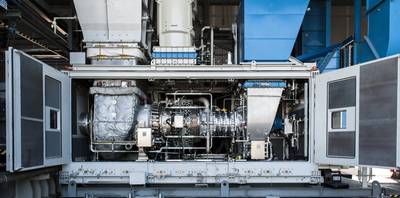Baker Hughes Plots Low Carbon Future

Snam and Baker Hughes recently tested the world’s first hydrogen blend turbine for gas networks (Photo: Baker Hughes)
Baker Hughes is pivoting to customers preparing for the transition to a low-carbon future, bolstering its footprint beyond oil and gas oilfield services, its chief executive said on Tuesday.
The company will continue to downsize its oilfield services and equipment portfolio, CEO Lorenzo Simonelli said at the Barclays CEO Energy-Power conference, putting more emphasis on the energy transition and technology needed for renewables. It has already been shedding some oilfield assets, such as its rod lift and specialty polymers businesses.
The strategic shift comes as more customers commit to lower carbon operations, and as growth in renewable energy such as wind and solar are accelerating. Baker Hughes has said it is targeting net-zero carbon emissions by 2050.
Baker Hughes is adjusting to a sharp drop in oil demand as the pandemic and a short-lived price war drove its biggest customers to idle equipment, slow new oil and liquefied natural gas (LNG) projects and cut employees. Global oil futures traded under $40 per barrel on Tuesday, below the breakeven price for many new projects.
"We believe that the changes facing the oil and gas markets and rapid growth in demand for lower carbon solutions warrant an acceleration of our strategy," Simonelli said in remarks to the virtual conference.
Baker Hughes sees opportunities as more companies move to lower their carbon footprints, including by upgrading gas turbines to reduce carbon emissions and buying methane monitoring products. Its also scaling up remote monitoring gear.
Longer-term it sees opportunities in carbon capture, the hydrogen value-chain and energy storage, particularly as renewable energy grows, Simonelli said.
Through its Turbomachinery and Process Solutions and Digital Solutions businesses, Baker Hughes will focus on providing energy solutions to a wide array of industries, including those outside the fossil fuels sector.
"Given subdued upstream outlook, the primary growth opportunities we see within our existing product footprint are the broader industrial sector, chemical and nonmetallic materials," Simonelli said. He said they would target industries including mining, food and beverage, power and pulp and paper.
(Reporting by Liz Hampton; Editing by Marguerita Choy)











